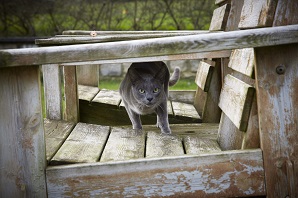How to keep cats out of your garden | Cat Safety

We aren’t the only ones who like to spend time outside enjoying our gardens – our cats love to get out and about as well.
Your garden provides a stimulating and exciting place for your cat to explore. However, it’s also important to remember that the garden can be dangerous for cats, plus you may find yourself with other feline visitors who may not be welcome.
Here are Petplan’s top tips for keeping your pet safe and happy in the garden, and keeping any unwanted cats out…
How to keep unwanted cats out of your garden
Don’t leave food out for your cat
If your cat is spending the days outside, sunning and exploring your garden, it may be tempting to leave food out for it as it may be reluctant to come in.
However, this will attract other cats. Ensuring that you only feed your cat inside your home will reduce the food options for neighbourhood cats and help to keep them away from your cat’s territory.
Cleaning up properly after a BBQ is also an important consideration as neighbourhood cats will relish the chance to eat any hamburger chunks that are littering your lawn, while stray bones can also cause injuries.
Good fencing and even sprinklers can help
Cats are incredibly agile and able to squeeze through some incredibly small spaces.
Because of this, you need to ensure that your garden is secure and that any gaps in fencing or possible entry points for other cats are addressed.
Another safe way to deter neighbourhood cats entering your garden is by installing motion sensor sprinklers and turn them on when your cat is no longer in the garden, while removing cat-attractive items such bird feeders can help reduce visitors as well.
Make sure sheds and greenhouses are kept shut
Sheds and greenhouses offer an inviting place for neighbourhood cats to explore and relax in a warm and cosy environment.
Remove the temptation by making sure you securely lock yours so other cats – as well as your own – are unable to get in and potentially hurt themselves on the many dangerous items that can be littered throughout.
How to keep your cat safe in your garden
Check for any poisonous plants
Cats often chew on foliage to help digestion, aid getting rid of hair balls and to deal with parasites, so ensuring the plants in your garden are non-poisonous is essential. Some of the most common plants are highly toxic to cats and can even result in death.
Perhaps the most dangerous plant for cats due to its toxicity and sheer abundance are lilies. Several types of lilies (including Easter lily, Tiger lily, Rubrum lily, Japanese show lily) are highly toxic to cats and even eating a single leaf can result in severe poisoning.
If you think your cat may have ingested part of a lily, then symptoms to look out for include:
- Vomiting
- Lethargy
- Lack of appetitie
Time is of the essence and you should contact your vet immediately if you think they have eaten even part of a lily.
This type of poisoning can lead to kidney failure within approximately 36-72 hours. If your cat is treated within six hours then the chances of your cat surviving are very good – if treatment is left longer (and certainly beyond 18 hours) then the kidneys could be severely affected and your cat may not survive.
Other plants that can lead to severe poisoning in cats include:
- Azaleas
- Rhododendrons
- Foxglove
- Crocus
- Castor Bean
There are many other plants that can also be dangerous for your cats, so make sure you do your research and let your plant supplier know you have a cat before buying anything new for your garden.
Also, if you are a keen gardener, be aware that some products, such as slug bait, can be lethal to cats. Ensure all the products you buy are cat-friendly and, if in doubt, consult with your garden centre who will be able to offer you comprehensive advice.
Use a cat flap to let your cat access your home
If your cat is spending a lot of time outside, make it easy for them to come indoors as and when they require via a cat flap.
Other cats can be kept out of your home by using an electronic cat flap that is triggered by a sensor on your cat’s collar.
A cat flap means your cat is less likely to go to the toilet in your garden as their indoor litter box can always be accessed.
Similarly, children’s sandboxes can be very attractive as outdoor litter boxes to cats, but this is dangerous for children as roundworm parasites in faeces can cause Toxocariasis which may lead to stomach pain, headaches, coughing and a fever.
Keep sandboxes covered when not in use so your cat (or other neighbourhood cats) don’t use them for their business.
What are your top tips for keeping your garden safe? Let us know your thoughts below…


